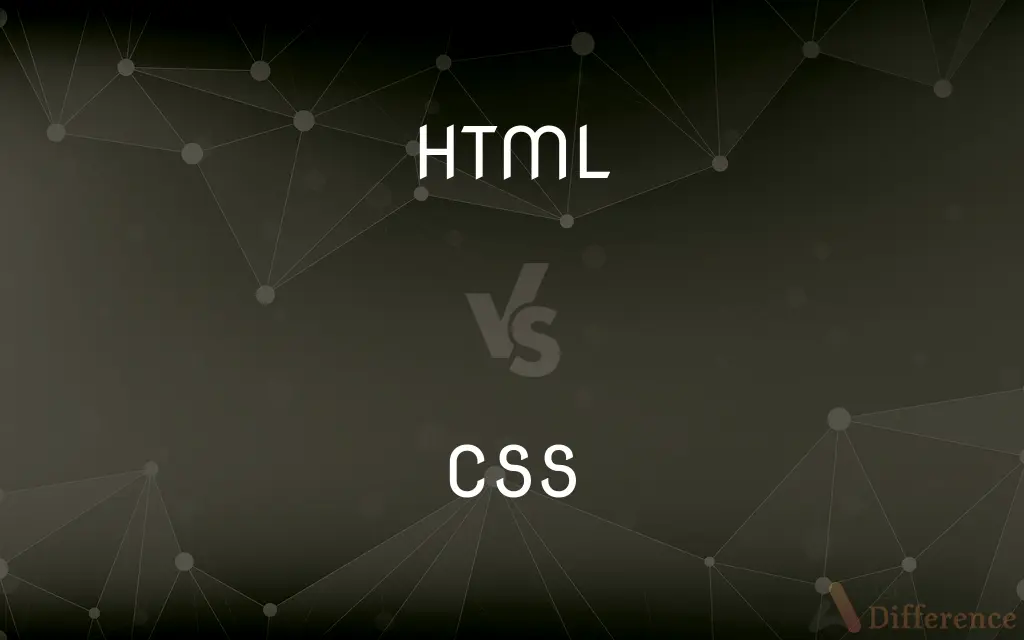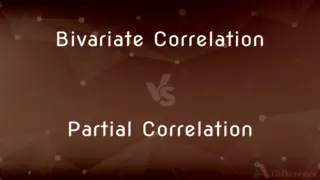HTML vs. CSS — What's the Difference?
By Tayyaba Rehman — Published on November 17, 2023
HTML (HyperText Markup Language) structures web content, while CSS (Cascading Style Sheets) styles it. Together, they create and design web pages.

Difference Between HTML and CSS
Table of Contents
ADVERTISEMENT
Key Differences
HTML, standing for HyperText Markup Language, is the standard language used to create the fundamental structure and content of web pages.
This includes elements like headings, paragraphs, links, and lists. In essence, HTML provides the skeleton for a webpage.
On the other hand, CSS, or Cascading Style Sheets, is a language primarily used to control the appearance or style of HTML elements on a page.
It defines the color, font, layout, and more, essentially giving the page its skin and style. CSS can make websites aesthetically pleasing and responsive to different device sizes.
While HTML is about content and structure, CSS is about presentation.
ADVERTISEMENT
For instance, HTML will indicate that a piece of text is a heading, but CSS will determine the color, font size, font type, and position of that heading.
Importantly, separating structure (HTML) from presentation (CSS) offers greater flexibility and maintainability for web development.
Changes in design can be easily implemented without altering the underlying content structure.
In a sense, if you consider building a website to constructing a house, HTML provides the bricks and foundation, whereas CSS gives the paint, decor, and furnishings.
Comparison Chart
Purpose
Structures web content
Styles web content
Language Type
Markup Language
Style-sheet Language
Interdependence
Can exist without CSS but will lack styling
Requires HTML to style
File Extension
.html or .htm
.css
Examples of Elements/Properties
Tags like <h1>, <p>, <a>
Properties like color, font-size, margin
Compare with Definitions
HTML
Uses tags to organize and structure web content.
With HTML tags like <h1> and <p>, I can create headings and paragraphs.
CSS
A language for describing the look and formatting of a web page.
I used CSS to change the color and font of my website's text.
HTML
Responsible for the skeleton of a webpage.
Without HTML, my webpage would lack structure and content.
CSS
Enables complex web designs without affecting content structure.
By using CSS, I added a unique design to my site without changing the HTML.
HTML
A standard language for creating web page structure.
I used HTML to define the headings and paragraphs of my website.
CSS
Controls the appearance across different devices and screen sizes.
With CSS, my website looks great on both mobile phones and desktops.
HTML
Establishes elements like links, lists, and forms on a site.
I added a navigation menu to my site using HTML.
CSS
Offers external, internal, and inline styling options.
I linked an external CSS file to apply consistent styles throughout my site.
HTML
Foundational for all websites and web apps.
Before adding any style or functionality, I first laid out my site using HTML.
CSS
Dictates visual aspects like color, layout, and fonts.
CSS made my plain HTML webpage vibrant and responsive.
HTML
A markup language used to structure text and multimedia documents and to set up hypertext links between documents, used extensively on the World Wide Web.
HTML
A set of tags and rules (conforming to SGML) for using them in developing hypertext documents
Common Curiosities
What does HTML stand for?
HTML stands for HyperText Markup Language.
Why should I separate HTML and CSS when designing a website?
It promotes cleaner code and allows for easier design updates without affecting content.
How can I make my website responsive using CSS?
Through media queries and flexible grid layouts.
What is the main purpose of CSS?
CSS is used to style and layout web pages.
How do I change the color of text using CSS?
Use the color property, e.g., color: red;.
Do I need to learn HTML before CSS?
Generally, yes. Understanding HTML structure aids in styling with CSS.
Can a website function with just HTML and no CSS?
Yes, but it would lack any advanced styling and design.
What is the significance of classes and IDs in CSS?
They allow specific styling of HTML elements. Classes are for multiple elements, while IDs are unique to one.
How do I link a CSS file to my HTML document?
Use the <link> tag in the HTML head section.
Are HTML and CSS programming languages?
No, HTML is a markup language and CSS is a style-sheet language. Neither is Turing complete.
Why might my CSS changes not appear on my website?
Potential reasons include browser cache, incorrect file paths, or specificity issues in the CSS code.
Can I embed CSS directly into HTML?
Yes, using the <style> tag in the head section or inline with the style attribute.
How does HTML interact with JavaScript?
JavaScript can manipulate HTML content and structure in real-time, creating dynamic webpages.
What's an example of an HTML element?
An example is the <p> tag, used for paragraphs.
Is it better to use multiple CSS files or one large one?
It depends. Multiple files can organize code, but one file reduces HTTP requests.
Share Your Discovery

Previous Comparison
Bivariate Correlation vs. Partial Correlation
Next Comparison
Charismatic Leadership vs. Transformational LeadershipAuthor Spotlight
Written by
Tayyaba RehmanTayyaba Rehman is a distinguished writer, currently serving as a primary contributor to askdifference.com. As a researcher in semantics and etymology, Tayyaba's passion for the complexity of languages and their distinctions has found a perfect home on the platform. Tayyaba delves into the intricacies of language, distinguishing between commonly confused words and phrases, thereby providing clarity for readers worldwide.
















































